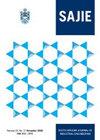复杂形状AA2024-W飞机蒙皮的冲压成形——从概念到最终部件
IF 0.5
4区 工程技术
Q4 ENGINEERING, INDUSTRIAL
引用次数: 0
摘要
早期阶段的产品设计需要一个更加量化的过程,以确保模拟研究的结果符合预期。本研究的目的是确定制造模拟软件包是否能够有效评估和验证概念化坯料和工具,以使用压模板液压成形制造大型复杂形状的铝合金飞机面板。坯料和工具概念通过成形工艺概念化循环进行概念化、评估和数字验证。在不需要对几个空白和工具概念进行物理试验的情况下,使用资源高效的开发过程实现了显著的节约。即使没有对超弹性橡胶元件进行建模,也能成功地进行模片液压成形模拟。然而,研究表明,必须适当地加入橡胶与金属的摩擦系数。该研究进一步表明,商业模拟包中缺乏准确评估模拟结果的标准计量方法。仿真计量学是一个新的感兴趣的领域,需要进一步发展。本研究有助于改进板料成形模拟过程,特别是模具板料液压成形过程模拟。这项研究将有利于航空航天和汽车行业,并促进数字化制造流程的采用。本文章由计算机程序翻译,如有差异,请以英文原文为准。
DIE SHEET HYDROFORMING OF A COMPLEX-SHAPED AA2024-W AIRCRAFT SKIN PANEL — FROM CONCEPT TO FINAL COMPONENT
Product design in the early stages requires a more quantitative process to ensure that the simulation study's outcome will meet expectations. The purpose of this study was to determine whether a manufacturing simulation software package could effectively evaluate and validate the conceptualised blank and tooling to manufacture a sizeable complex-shaped aluminium alloy aircraft panel using die sheet hydroforming. Blank and tool concepts were conceptualised, evaluated, and validated digitally using the forming process conceptualisation cycle. Without the need to trial several blank and tool concepts physically, a significant saving was achieved using a resource-efficient development process. Even without modelling the hyperelastic rubber elements, a successful die sheet hydroformed simulation result was conducted. However, the study showed that a rubber-to-metal friction coefficient must be incorporated appropriately. The study further showed the lack of standard metrology methods in commercial simulation packages to evaluate a simulation result accurately. Simulation metrology is a new area of interest that requires further development. This research contributes to improving the sheet metal forming simulation process and, specifically, die sheet hydroforming process simulation. The study will benefit the aerospace and automotive industry and promote the adoption of digital manufacturing processes.
求助全文
通过发布文献求助,成功后即可免费获取论文全文。
去求助
来源期刊
CiteScore
1.10
自引率
20.00%
发文量
15
审稿时长
6 weeks
期刊介绍:
The South African Journal of Industrial Engineering (SAJIE) publishes articles with the emphasis on research, development and application within the fields of Industrial Engineering and Engineering and Technology Management. In this way, it aims to contribute to the further development of these fields of study and to serve as a vehicle for the effective interchange of knowledge, ideas and experience between the research and training oriented institutions and the application oriented industry. Articles on practical applications, original research and meaningful new developments as well as state of the art surveys are encouraged.

 求助内容:
求助内容: 应助结果提醒方式:
应助结果提醒方式:


